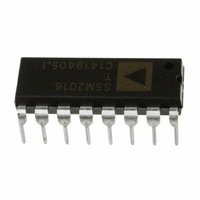SSM2018TPZ Analog Devices Inc, SSM2018TPZ Datasheet - Page 9

SSM2018TPZ
Manufacturer Part Number
SSM2018TPZ
Description
IC AMP AUDIO MONO CLASS AB 16DIP
Manufacturer
Analog Devices Inc
Datasheet
1.SSM2018PZ.pdf
(16 pages)
Specifications of SSM2018TPZ
Amplifier Type
Audio
Number Of Circuits
1
Slew Rate
5 V/µs
Gain Bandwidth Product
14MHz
Current - Input Bias
250nA
Voltage - Input Offset
1000µV
Current - Supply
11mA
Voltage - Supply, Single/dual (±)
10 V ~ 36 V, ±5 V ~ 18 V
Operating Temperature
-40°C ~ 85°C
Mounting Type
Through Hole
Package / Case
16-DIP (0.300", 7.62mm)
Amplifier Class
AB
No. Of Channels
1
Supply Voltage Range
± 5V To ± 18V
Load Impedance
100kohm
Operating Temperature Range
-40°C To +85°C
Amplifier Case Style
DIP
No. Of Pins
16
Rohs Compliant
Yes
Lead Free Status / RoHS Status
Lead free / RoHS Compliant
Output Type
-
Current - Output / Channel
-
-3db Bandwidth
-
Available stocks
Company
Part Number
Manufacturer
Quantity
Price
Company:
Part Number:
SSM2018TPZ
Manufacturer:
MICREL
Quantity:
12 500
REV. B
shown later in the data sheet. Thus, for the Basic VCA circuit
or the OVCE circuit, COMP3 should be left open.
A compensation capacitor does need to be added between
COMP1 and COMP2. Because the VCA operates over such a
wide gain range, the compensation should ideally be optimized
for each gain. When the VCA is in high attenuation, there is
very high “loop gain,” and the part needs to have high compen-
sation. On the other hand, at high gain, the same compensation
capacitor would overcompensate the part and roll off the high
frequency performance. Thus, the SSM2018T employs a patented
adaptive compensation circuit. The compensation capacitor is
“Miller” connected between the base and collector of an inter-
nal transistor. By changing the gain of this transistor via the
control voltage, the compensation is changed.
Increasing the compensation capacitor causes the frequency
response and slew rate to decrease, which tends to cause high
frequency distortion to increase. For the basic VCA circuit, 47
pF was chosen as the optimal value. The OVCE circuit described
later uses a 220 pF capacitor. The reason for the increase is to
compensate for the extra phase shift from the additional output
amplifier used in the OVCE configuration. The compensation
capacitor can be adjusted over a practical range from 47 pF to
220 pF if desired. Below 47 pF, the parts may oscillate; above
220 pF the frequency response is significantly degraded.
Control Section
As noted above, the control voltage on Pin 11 steers the current
through the gain core transistors to set the gain. The unity gain
(0 dB) condition occurs at V
VCA for positive voltages (0 V to 3 V, typ), and gain occurs for
negative voltage (0 V to –1.3 V, typ). From –1.3 V to
+3.0 V, 140 dB of gain range is obtainable. The output gain
formula is as follows:
V
OUT
= V
IN
+IN
–IN
V–
¥ e
(–aV
C
)
C
= 0. Attenuation occurs in the
COMP 2
COMPENSATION
Figure 2. SSM2018T Detailed Functional Diagram
NETWORK
COMP 3
COMP 1
A3
(1)
–I
Im + (
1–G
G
–9–
Q1
Is
2
)
Q2
The exponential term arises from the standard Ebers-Moll
equation describing the relationship of a transistor’s collector
current as a function of the base-emitter voltage:
The factor “a” is a function not only of V
due to the resistor divider of the 200 W and 1.8 kW resistors
shown in Figure 2. The resulting expression for “a” is as follows:
a = 1/(10 ¥ V
temperature. Substituting a = 4 in the above equation results in
a –28.8 mV/dB control law at room temperature.
The –28.8 mV/dB number is slightly different from the data
sheet specification of –30 mV/dB. The difference arises from
the temperature dependency of the control law. The term V
is known as the thermal voltage, and it has a direct dependency
on temperature: V
1.38E–23, q = electron charge = 1.6E–19, and T = absolute
temperature in Kelvin). This temperature dependency leads to
the –3500 ppm/∞C drift of the control law. It also means that the
control law changes as the part warms up. Thus, our specifica-
tion for the control law states that the part has been powered up
for 60 seconds.
When the part is initially turned on, the temperature of the die
is still at the ambient temperature (25∞C for example), but the
power dissipation causes the die to warm up. With ±15 V supplies
and a supply current of 11 mA, 330 mW is dissipated. This
number is multiplied by q
temperature. In this case, the die increases from 25∞C to approxi-
mately 50∞C. A 25∞C temperature change causes a 8.25%
increase in the gain constant, resulting in a gain constant of 30
mV/dB. The graph in Figure 17 shows how the gain constant
varies over the full temperature range.
G
SPLITTER
200
I
A1
C
= I
G
S
Q3
¥ e
+I
Im – (
Q4
(V
1-G
T
BE
1–G
), which is approximately equal to 4 at room
Is
2
/V
)
GAIN
CORE
T
A2
)
T
200
= kT/q (k = Boltzmann’s constant =
V
REF
Im
JA
to determine the rise in the die’s
1.8k
A4
A4
T
but also the scaling
SSM2018T
V
BAL
–I
V
GND
MODE
1-G
C
1-G
T
(2)













